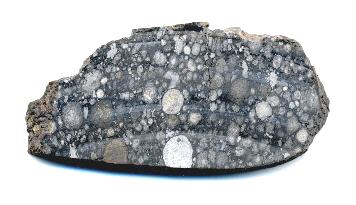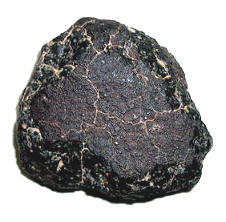CV3.5 
click on photos for a magnified view Found October 2001
no coordinates recorded A single small stone weighing 57.1 g was probably found near Boudnib, Morocco, and was subsequently purchased in Erfoud. Analysis was conducted at the Muséum National d’Histoire Naturelle in Paris. The analyses thus far have determined that NWA 1763 is a carbonaceous chondriteCarbonaceous chondrites represent the most primitive rock samples of our solar system. This rare (less than 5% of all meteorite falls) class of meteorites are a time capsule from the earliest days in the formation of our solar system. They are divided into the following compositional groups that, other than Click on Term to Read More of the CV group with a petrologic typeMeasure of the degree of aqueous alteration (Types 1 and 2) and thermal metamorphism (Types 3-6) experienced by a chondritic meteorite. Type 3 chondrites are further subdivided into 3.0 through 3.9 subtypes. of 3.5 (Fa0.27–34.91; Fs0.69–2.34). It is both unshocked (S0) and unweathered (W0), with an unoxdized matrixFine grained primary and silicate-rich material in chondrites that surrounds chondrules, refractory inclusions (like CAIs), breccia clasts and other constituents. Click on Term to Read More and an abundance of intact sulfide. The pristine condition of this CV3.5 chondriteChondrites are the most common meteorites accounting for ~84% of falls. Chondrites are comprised mostly of Fe- and Mg-bearing silicate minerals (found in both chondrules and fine grained matrix), reduced Fe/Ni metal (found in various states like large blebs, small grains and/or even chondrule rims), and various refractory inclusions (such Click on Term to Read More should prove helpful in continued studies of this carbonaceous chondrite group.
Northwest Africa 1763, along with most carbonaceous
chondritesChondrites are the most common meteorites accounting for ~84% of falls. Chondrites are comprised mostly of Fe- and Mg-bearing silicate minerals (found in both chondrules and fine grained matrix), reduced Fe/Ni metal (found in various states like large blebs, small grains and/or even chondrule rims), and various refractory inclusions (such Click on Term to Read More, contains many
refractory inclusionsInclusions found predominantly in carbonaceous chondrites and are rich in refractory elements particularly calcium, aluminum and titanium that in various combinations form minerals such as spinel, melilite, perovskite and hibonite. There are two types of refractory inclusion: • Ca Al-rich inclusions (CAIs) • Amoeboid olivine aggregates (AOAs) Refractory inclusions were Click on Term to Read More of calcium and aluminum (
CAIsSub-millimeter to centimeter-sized amorphous objects found typically in carbonaceous chondrites and ranging in color from white to greyish white and even light pink. CAIs have occasionally been found in ordinary chondrites, such as the L3.00 chondrite, NWA 8276 (Sara Russell, 2016). CAIs are also known as refractory inclusions since they Click on Term to Read More) that were probably formed by condensation at temperatures high enough to vaporize the Fe and Mg silicates. One theory places their formation early in nebular history when the heat source was the gravitational energy of the accreting stellar disk. Outward
diffusionMovement of particles from higher chemical potential to lower chemical potential (chemical potential can in most cases of diffusion be represented by a change in concentration). Diffusion, the spontaneous spreading of matter (particles), heat, or momentum, is one type of transport phenomena. Because diffusion is thermally activated, coefficients for diffusion Click on Term to Read More mechanisms allowed some CAIs to escape solar
accretionAccumulation of smaller objects into progressively larger bodies in the solar nebula leading to the eventual formation of asteroids, planetesimals and planets. The earliest accretion of the smallest particles was due to Van der Waals and electromagnetic forces. Further accretion continued by relatively low-velocity collisions of smaller bodies in the Click on Term to Read More and become stabilized in the outer, zero-drag, newly formed Jovian gap. It was further proposed that surface flares from Jupiter then formed
chondrulesRoughly spherical aggregate of coarse crystals formed from the rapid cooling and solidification of a melt at ~1400 ° C. Large numbers of chondrules are found in all chondrites except for the CI group of carbonaceous chondrites. Chondrules are typically 0.5-2 mm in diameter and are usually composed of olivine Click on Term to Read More, and both components were ultimately incorporated into a carbonaceous assemblage. More recently, theories have attributed the formation of chondrules to shock waves caused by gravitational instabilities.
Yet, another theory of
CAISub-millimeter to centimeter-sized amorphous objects found typically in carbonaceous chondrites and ranging in color from white to greyish white and even light pink. CAIs have occasionally been found in ordinary chondrites, such as the L3.00 chondrite, NWA 8276 (Sara Russell, 2016). CAIs are also known as refractory inclusions since they Click on Term to Read More origin places the formation at a later period, when the accretion phase was over and the
SunOur parent star. The structure of Sun's interior is the result of the hydrostatic equilibrium between gravity and the pressure of the gas. The interior consists of three shells: the core, radiative region, and convective region. Image source: http://eclipse99.nasa.gov/pages/SunActiv.html. The core is the hot, dense central region in which the was in its T Tauri phase. The
solar windSupersonic flow of high-speed charged particles continuously blowing off a star (mostly e- and p+). When originating from stars other than the Sun, it is sometimes called a "stellar" wind. The solar wind may be viewed as an extension of the corona into interplanetary space. The solar wind emanates radially swept the volatile-rich gas from the outer layers of the nebular disk leaving only refractory-rich dust behind.
Shock waveAbrupt perturbation in the temperature, pressure and density of a solid, liquid or gas, that propagates faster than the speed of sound. heating then evaporated the Fe and Mg silicates, leaving the dust enriched in Al. This dust eventually coalesced, and was melted to form the CAIs that are present in most carbonaceous meteorites. More recently, studies have shown that CAIs were accreted rapidly into larger bodies, heated by the decay of
26Al, and thermally metamorphosed. Thereafter, these bodies were disrupted, and the CAIs were returned to the
nebulaAn immense interstellar, diffuse cloud of gas and dust from which a central star and surrounding planets and planetesimals condense and accrete. The properties of nebulae vary enormously and depend on their composition as well as the environment in which they are situated. Emission nebula are powered by young, massive Click on Term to Read More to be remixed and recycled into later carbonaceous chondrite bodies. Layered rims surrounding some CAIs, referred to as Wark–Lovering rims or accretionary rims, were possibly formed by a flash heating event in a more
oxidizingOxidation and reduction together are called redox (reduction and oxidation) and generally characterized by the transfer of electrons between chemical species, like molecules, atoms or ions, where one species undergoes oxidation, a loss of electrons, while another species undergoes reduction, a gain of electrons. This transfer of electrons between reactants Click on Term to Read More environment of the
solar nebulaThe primitive gas and dust cloud around the Sun from which planetary materials formed.. This heating event was measured in fractions of a second and resulted in a loss of volatiles with enrichment of the refractory component, along with the subsequent diffusion of O and Mg. During the flash heating event, temperatures at the rim are inferred to have approached 3000°C, steeply decreasing to temperatures of ~1700°C just 1 mm below the rim. Subsequent chemical and isotopic exchange, corresponding to the grain size and
porosityThe volume percentage of a rock that consists of void space. Vesicular porosity is a type of porosity resulting from the presence of vesicles, or gas bubbles, in igneous rock such as the pumice presented here. Vesicular porosity is very rare in meteorites and is often associated with slag, one Click on Term to Read More of specific minerals, most likely occurred
in situ on the
parent bodyThe body from which a meteorite or meteoroid was derived prior to its ejection. Some parent bodies were destroyed early in the formation of our Solar System, while others like the asteroid 4-Vesta and Mars are still observable today. Click on Term to Read More.
The CV3 group has been subdivided into four subgroups (McSween, 1977; Weisberg
et al., 1997; Wasson
et al., 2013):
- ReducedOxidation and reduction together are called redox (reduction and oxidation) and generally characterized by the transfer of electrons between chemical species, like molecules, atoms or ions, where one species undergoes oxidation, a loss of electrons, while another species undergoes reduction, a gain of electrons. This transfer of electrons between reactants Click on Term to Read More subgroup: e.g., Arch, Efremovka, Leoville, Vigarano, and QUE 93429
- Oxidized-Allende subgroup: e.g., Allende, Axtell, Tibooburra, and ALH 84028
- Oxidized-Bali subgroup: e.g., Bali, Grosnaja, Kaba, and Mokoia
The oxidized-Allende and reduced subgroups are separated on the basis of metalElement that readily forms cations and has metallic bonds; sometimes said to be similar to a cation in a cloud of electrons. The metals are one of the three groups of elements as distinguished by their ionization and bonding properties, along with the metalloids and nonmetals. A diagonal line drawn Click on Term to Read More abundances and the Ni content of sulfide (Howard et al., 2010). The previously used discriminator, magnetiteFe oxide, Fe2+Fe3+2O4, containing oxidized iron (Fe3+) found in the matrix of carbonaceous chondrites and as diagnostic component in CK chondrites. In CK chondrites, magnetite is typically chromian, containing several wt. % Cr2O3. Click on Term to Read More abundance, has been shown to overlap between oxidizedOxidation and reduction together are called redox (reduction and oxidation) and generally characterized by the transfer of electrons between chemical species, like molecules, atoms or ions, where one species undergoes oxidation, a loss of electrons, while another species undergoes reduction, a gain of electrons. This transfer of electrons between reactants Click on Term to Read More and reduced subgroups. The oxidized-Bali subgroup has a higher degree of aqueous alteration than oxidized-Allende (for more mineralogical relationships, see Appendix I, Carbonaceous Chondrites). The subgroup to which NWA 1763 belongs has not yet been published, but it likely belongs to the oxidized-Allende subgroup.
Some investigators (
e.g., Greenwood
et al., 2003 and Wasson
et al., 2013) have proposed that the CK chondrites could represent an extension of the CV group. This subgroup is considered to reflect varying degrees of metamorphism including impact-generated crushing, thermal alteration, and recrystallization processes (Wasson
et al., 2013). In a subsequent study, Dunn
et al. (2016) compared magnetite in a number of CK and
CV chondritesMeteorite class named after the Vigarano meteorite that fell in Italy in 1910. They have abundant large, well-defined rimless (?) chondrules of magnesium-rich olivine (~0.7 mm diameter; 40-65 vol. %), often surrounded by iron sulfide. They also contain 7-20 vol. % CAIs. The often dark-gray matrix is dominated by Fe-rich Click on Term to Read More, and presented geochemical, mineralogical, and petrographic evidence which is more consistent with separate CV and CK parent bodies; details of their study can also be found on the
Dhofar 015 page.
The first naturally occuring quasicrystal, dubbed icosahedrite, was discovered by Princeton University scientists embedded in
stishoviteDense, high-pressure phase of quartz; so far identified only in shock-metamorphosed, quartz-bearing rocks from meteorite impact craters. Stishovite was synthesized in 1961 before it was discovered at Meteor Crater, Arizona. Its structure consists of parallel chains of single SiO6 octahedra. The octahedra are on their sides, sharing opposing edges. Image Click on Term to Read More grains inside a rare
mineralInorganic substance that is (1) naturally occurring (but does not have a biologic or man-made origin) and formed by physical (not biological) forces with a (2) defined chemical composition of limited variation, has a (3) distinctive set of of physical properties including being a solid, and has a (4) homogeneous Click on Term to Read More called khatyrkite.
OxygenElement that makes up 20.95 vol. % of the Earth's atmosphere at ground level, 89 wt. % of seawater and 46.6 wt. % (94 vol. %) of Earth's crust. It appears to be the third most abundant element in the universe (after H and He), but has an abundance only Click on Term to Read More isotopic values of the icosahedrite quasicrystals are similar to those of CV3 carbonaceous chondrites which suggests a common extraterrestrial origin in the solar nebula over 4.5 billion years ago (Bindi
et al., 2012,
PNAS). The specimen of NWA 1763 pictured above is a 3.35 g slice (some saw marks are evident in the photo). A photo of the complete, fresh stone as found is shown below.

Photo courtesy of Philippe Thomas—
Meteoritica








